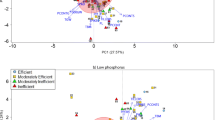Abstract
Approximately 11,500 seedlings from 510 lines of perennial rye-grass (Lolium perenne L.) were screened for tolerance to aluminium (Al) using a low ionic strength ‘still’ solution culture technique. Although none of the individual lines were consistently more tolerant than any other line, 23 individual plants were selected from 13 lines for superior vigour and colour in the presence of Al.
The growth of three of these elite plants was examined on a reconstructed acid soil profile protected from prevailing weather conditions allowing control of the moisture status of the soil. The plants selected for Al tolerance in solution culture had significantly higher yields before drought and after recovery from drought than the rye-grass cultivars Ariki, Ellett and Droughtmaster and 4 other hill country lines which were previously selected for high yields in the presence and absence of nitrogen, and for drought and grassgrub resistance. Of the total number of plants tested from all cultivars and lines, <2% had yields that were greater than one third of the yields of the 3 Al tolerant plants. The better performance of the Al tolerant plants is attributed to better root growth in the acid soil.
Three polycrosses were made from the 23 Al tolerant plants selected in solution culture. When tested in solution culture, the yields of the half-sib families in the presence of Al averaged approximately twice that of Grasslands Nui in one experiment, but were similar to Grasslands Nui in another. Heritability of total yield and relative yield in the presence of Al, calculated from half-sib measurements on a single replicate basis, averaged 0.33 and 0.24 respectively. Individual plants from the half-sib families from two polycrosses were grown in a nursery and heading date and vigour recorded. There were no significant differences in heading data between the polycross lines and either of the cultivars Grasslands Nui or Yatsyn. Although there were significant differences in spring vigour between lines, they were not significantly different from either Grasslands Nui or Yatsyn. Twelve of the polycross lines showed decreased vigour in summer and autumn. This decline in vigour was attributed to damage from Argentine stem weevil (Listronotus bonariensis) as a consequence of low levels of lolium endophyte (Acremonoim lolii).
Similar content being viewed by others

References
Edmeades D C, Pringle R M, Mansell G P, Shannon P W, Ritchie J and Stewart K W 1985 Effects of lime on pasture production on soil in the North Island of New Zealand. 5. Description of a lime recommendation scheme. N.Z. J. Exp. Agric. Res. 13, 47–58.
Edmeades D C, Blamey F P C, Asher C J and Edwards D G 1991a Effects of pH and aluminium on the growth of temperate pasture species. 1. Temperate grasses and legumes supplied with inorganic nitrogen. Aust. J. Agric. Res. 42, 559–69.
Edmeades D C, Wheeler D M and Christie R A 1991b The effect of Aluminium and pH on the Growth of a Range of Temperate Grass Species and Cultivars. In Plant-Soil Interactions at Low pH. Eds. R J Wright, V C Baligar and R P Murrmann. pp 913–924. Kluwer Academic Publishers, Dordrecht, The Netherlands.
Hanson W D 1963 Heritability. In Statistical Genetics and Plant Breeding. Eds. W D Hanson and H F Robson. Publication 962, National Academy of Science/National Research Council, Washington DC.
Helyar K R and Porter W M 1989 Soil acidification, its measurement and the processes involved. In Soil Acidity and Plant Growth. Ed. A D Robson. pp 61–101. Academic Press, Australia.
Parker D R, Zelazny L W and Kinraide T B 1987 Improvements to the program GEOCHEM. Soil Sci. Soc. Am. J. 51, 488–491.
Prestidge R A, Pottinger R P and Barker G M 1982 An association of Lolium endophyte with ryegrass resistance to Argentine Stem Weevil. Proc. N.Z. Weed and Pest Control Conference 35, 119–22.
Sposito G and Mattigod S V 1980 GEOCHEM: A Computer Program for the Calculation of Chemical Equilibra in Soil Solution and other Natural Water Systems. Kearney Foundation of Soil Science, University of California, Riverside, CA.
Wedderburn M E, Pengelly W J and Tucker M A 1989 Simulated soil profiles as a plant screening technique. Proc. of the N.Z. Grass. Assoc. 50, 249–252.
Wedderburn M E, Tucker M A, Pengelly W J and Ledgard S F 1990 Responses of a New Zealand North Island hill perennial ryegrass collection to nitrogen, moisture stress, and grass grub (Costelytra zealandica) infestation. N.Z. J. Agric. Res. 33, 405–411.
Author information
Authors and Affiliations
Rights and permissions
About this article
Cite this article
Wheeler, D.M., Edmeades, D.C., Smith, D.R. et al. Screening perennial rye-grass from New Zealand for aluminium tolerance. Plant Soil 146, 9–19 (1992). https://doi.org/10.1007/BF00011990
Issue Date:
DOI: https://doi.org/10.1007/BF00011990



